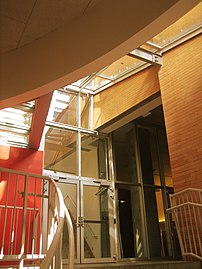Yesterday I was privileged to be invited to give a talk at the NESTA Crucible Workshop being held in Lancaster. You can find the slides on slideshare. NESTA, the National Endowment for Science, Technology, and the Arts, is an interesting organization funded via a UK government endowment to support innovation and enterprise and more particularly the generation of a more innovative and entrepreneurial culture in the UK. Among the programmes it runs in pursuit of this is the Crucible program where a small group of young researchers, generally looking for or just in their first permanent or independent positions, attend a series of workshops to get them thinking broadly about the role of their research in the wider world and to help them build new networks for support and collaboration.
My job was to talk about “Science in Society” or “Open Science”. My main theme was the question of how we justify taxpayer expenditure on research; that to me this implies an obligation to maximise the efficiency of how we do our research. Research is worth doing but we need to think hard about how and what we do. Not surprisingly I focussed on the potential of using web based tools and open approaches to make things happen cheaper, quicker, and more effectively. To reduce waste and try to maximise the amount of research output for the money spent.
Also not surprisingly there was significant pushback – much of it where you would expect. Concerns over data theft, over how “non-traditional” contributions might appear (or not) on a CV, and over the costs in time were all mentioned. However what surprised me most was the pushback against the idea of putting material on the open web versus traditional journal formats. There was a real sense that the group had a respect for the authority of the printed, versus online, word which really caught me out. I often use a gotcha moment in talks to try and illustrate how our knowledge framework is changed by the web. It goes “how many people have opened a physical book for information in the last five years?”. Followed by “and how many haven’t used Google in the last 24 hours”. This is shamelessly stolen from Jamie Boyle incidentally.
Usually you get three or four sheepish hands going up admitting a personal love of real physical books. Generally it is around 5-10% of the audience, and this has been pretty consistent amongst mid-career scientists in both academia and industry, and people in publishing. In this audience about 75% put their hands up. Some of these were specialist “tool” books, mathematical forms, algorithmic recipes, many of them were specialist texts and many referred to the use of undergraduate textbooks. Interestingly they also brought up an issue that I’ve never had an audience bring up before; that of how do you find a good route into a new subject area that you know little about, but that you can trust?
My suspicion is that this difference comes from three places, firstly that these researchers were already biased towards being less discipline bound by the fact that they’d applied for the workshop. They were therefore more likely to discipline hoppers, jumping into new fields where they had little experience and needed a route in. Secondly, they were at a stage of their career where they were starting to teach, again possibly slightly outside their core expertise and therefore looking for good, reliable material, to base their teaching on. Finally though there was a strong sense of respect for the authority of the printed word. The printing of the German Wikipedia was brought up as evidence that printed matter was, at least perceived to be, more trustworthy. Writing this now I am reminded of the recent discussion on the hold that the PDF has over the imagination of researchers. There is a real sense that print remains authoritative in a way that online material is not. Even though the journal may never be printed the PDF provides the impression that it could or should be. I would guess also that the group were young enough also to be slightly less cynical about authority in general.
Food for thought, but it was certainly a lively discussion. We actually had to be dragged off to lunch because it went way over time (and not I hope just because I had too many slides!). Thanks to all involved in the workshop for such an interesting discussion and thanks also to the twitter people who replied to my request for 140 character messages. They made a great way of structuring the talk.




